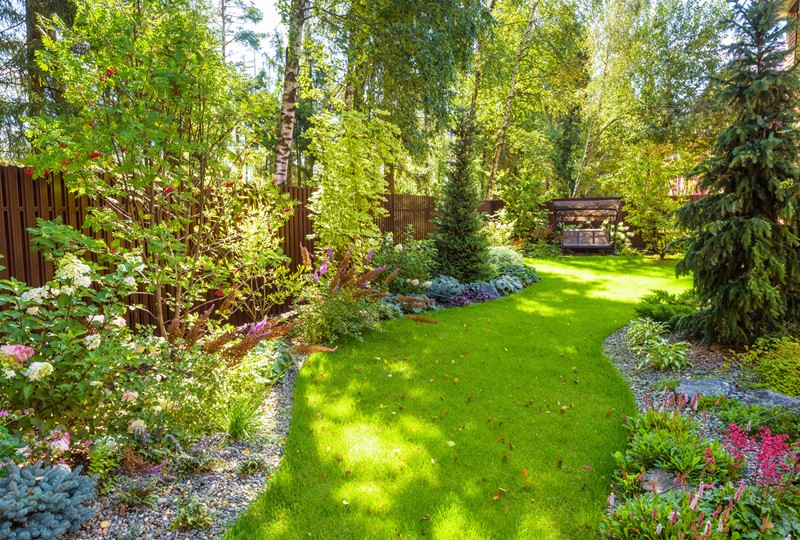
Key insights:
- Embrace the concept of “No Mow May” by incorporating native plants in your landscaping.
- Native plants and pollinators are on the decline. Creating a natural habitat in your yard may help to revive these local species.
- Wildflower and clover yards require less maintenance and water than the traditional grass yard, which saves homeowners money and time.
A recent push for “No Mow May” has taken social media and local governments by storm. This trend encourages the growth of native plants and grasses in order to protect natural wildlife and habitat.
Follow along if you’re interested in replacing your green, manicured lawn with an equally luscious alternative that also supports local pollinators and plant species.
Plant a wildflower or clover yard
While a yard full of wildflowers or clovers may sound like a whimsical fairytale, it’s becoming a desired lawn feature for households across the country – and not just for its beauty. Even though these natural plants offer a beautiful sight, the addition of such greenery serves a greater purpose: to build back lost habitats for insects. Currently, 40% of insect species are on the decline. Building back their natural habitat with wildflowers or clover may help to save these small, vital creatures.
Wildflower
A yard full of wildflowers is one of the best options for encouraging the biodiversity of plants, insects and birds. Once these yards are established, they require much less upkeep than a typical grass lawn. It’s important to use seeds for flowers that grow naturally in your area. Here are some popular native plant species to use in lawns throughout Minnesota and western Wisconsin:
- Black chokeberry
- Blue false indigo
- Blue flag iris
- Bush honeysuckle
- Butterfly milkweed
- Cardinal flower
- Michigan lily
- Purple coneflower
- Red osier dogwood
- Swamp milkweed
- Wild columbine
- Wild geranium
Clover
Clover yards are easy to plant and a breeze to maintain. With this style of yard, homeowners can potentially mix clover with native grasses to add interest to their lawn. Plus, clover requires less water than the standard lawn – and it costs less to plant, too. The most commonly used clover species are:
- Micro clover
- Dutch white clover
- Red clover
And, if you’re concerned that planting wildflowers or clovers will create an overly buggy yard, don’t worry! There are plenty of ways to naturally mosquito-proof your yard so you can continue to enjoy your patio and lawn without irritating bug bites.
The benefits of native flowers and grasses
Creating pollinator gardens, incorporating native plants in your landscaping or planting a full-fledged wildflower or clover yard all offer a variety of benefits. Here are some of the advantages associated with this style of natural yard:
- Creates refuge for bees, birds, beetles, butterflies and other pollinators
- Allows for plants to grow freely, which increases biodiversity
- Generates visual interest
- Reduces runoff and erosion
- Saves you time and money on yard maintenance
Maintain your yard naturally
Here are some tips to create a natural and inviting outdoor space for both your enjoyment and to help the pollinators and plants thrive:
- Prepare your soil (and use your own compost as fertilizer!)
- Plant wildflower, clover or natural grass seeds
- Plant fruits and vegetables that you enjoy
- Water seeds only when necessary
- Eliminate or reduce pesticide usage
- Incorporate shrubs and sections of mulch for visual interest and erosion protection
- Set up a seating area with citronella candles
Looking for more natural yard tips? Moving forward, get in touch with Edina Realty or your agent for more ways to maintain or enhance your home’s curb appeal.









 ©2025 Prosperity Home Mortgage LLC®. (877) 275-1762. 3060 Williams Drive, Suite 600, Fairfax, VA 22031. All first mortgage products are provided by Prosperity Home Mortgage, LLC®. Not all mortgage products may be available in all areas. Not all borrowers will qualify. NMLS ID #75164 (For licensing information go to: NMLS Consumer Access at
©2025 Prosperity Home Mortgage LLC®. (877) 275-1762. 3060 Williams Drive, Suite 600, Fairfax, VA 22031. All first mortgage products are provided by Prosperity Home Mortgage, LLC®. Not all mortgage products may be available in all areas. Not all borrowers will qualify. NMLS ID #75164 (For licensing information go to: NMLS Consumer Access at